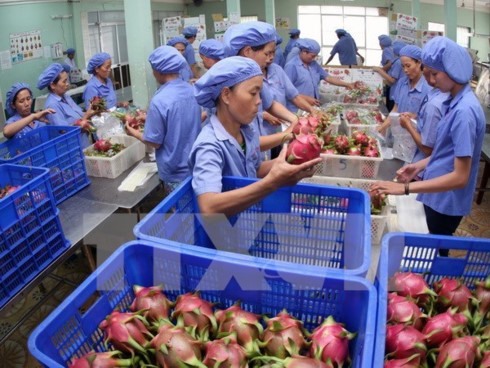 Economy
Economy

Việt Nam’s fruit and vegetable exports reached US$1.32 billion in the first four months of the year, a year-on-year increase of 30 per cent, according to the Ministry of Agriculture and Rural Development.
 |
| Workers select dragon fruit for export. — VNA/VNS Photo |
HCM CITY — Việt Nam’s fruit and vegetable exports reached US$1.32 billion in the first four months of the year, a year-on-year increase of 30 per cent, according to the Ministry of Agriculture and Rural Development.
This is the first time fruit and vegetable’s trade value surpassed that of oil.
With a high export growth rate in the past four years, the sector is expected to surpass the export target of $4 billion set this year.
Việt Nam was recently officially allowed to export fresh rambutan to New Zealand after seven years of negotiations, opening opportunity for Vietnamese fruits and vegetables to tap other strict markets in the world.
Minister of Agriculture and Rural Development Nguyễn Xuân Cường said global trade for fruits and vegetables was worth $230 billion a year with an annual growth rate of 3-5 per cent per year, but there is still more room for Việt Nam to boost fruit and vegetable exports.
To take advantage of market opportunities, in addition to building more modern processing facilities, the sector must build qualified raw material areas for export, he said.
Despite achieving impressive results in export, the sector has encountered risks since it has relied too much on the Chinese market, according to experts.
In the past years, China has been Việt Nam’s biggest fruit and vegetable importer. In the first four months of the year, exports to China accounted for 77 per cent of the country’s fruit and vegetable exports, with the US ranking second (accounting for 2.84 per cent) and Japan third (2.7 per cent).
Dr Nguyễn Minh Châu, former director of the Southern Fruit Research Institute, said China was as an important export market of Việt Nam, but export market should be diversified to mitigate risks of depending heavily on one market.
The fruit and vegetable sector and the agricultural sector in general had mapped out plans to diversify export markets by exploring other potential markets.
According to the Việt Nam Fruit and Vegetable Association, fruit and vegetable exports have faced difficulties in payments as well as technical barriers. Amid global economic integration, when tariffs fall, technical barriers often increase.
Hoàng Trung, director of the Ministry of Agriculture and Rural Development’s Plant Protection Department, said to open the export market for fruits, businesses and producers must meet two barriers set by import countries: stringent quarantine requirements and hygiene and food safety regulations, especially plant protection residues on fruits and vegetables.
His department had granted nearly 6,000 code numbers for cultivation areas for dragon fruits, mango, longan, rambutan and litchi.
The department had coordinated with localities to provide more code numbers for qualified growing areas for export, he said.
Importing countries require an orchard garden of the product along with a code to ensure traceability as well as to facilitate the application of pest-control measures.
Minister Cường said opening a new market for a product was not an easy task, so all stakeholders involved in the sector must retain the market by strictly complying with closed production chain to ensure product quality and production costs, and to enhance credibility in open markets. — VNS




